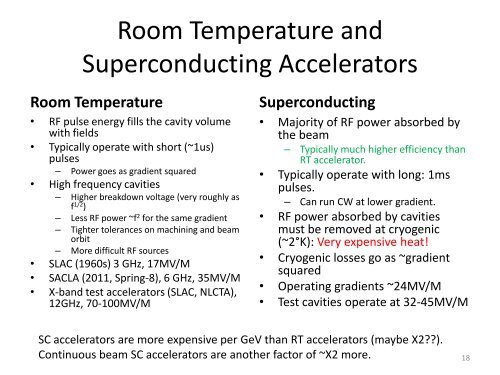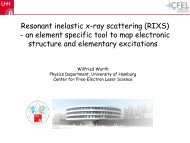Joe Frisch: Synchrotron radiation sources and free ... - Conferences
Joe Frisch: Synchrotron radiation sources and free ... - Conferences
Joe Frisch: Synchrotron radiation sources and free ... - Conferences
You also want an ePaper? Increase the reach of your titles
YUMPU automatically turns print PDFs into web optimized ePapers that Google loves.
Room Temperature <strong>and</strong><br />
Superconducting Accelerators<br />
Room Temperature<br />
• RF pulse energy fills the cavity volume<br />
with fields<br />
• Typically operate with short (~1us)<br />
pulses<br />
– Power goes as gradient squared<br />
• High frequency cavities<br />
– Higher breakdown voltage (very roughly as<br />
f 1/2 )<br />
– Less RF power ~f 2 for the same gradient<br />
– Tighter tolerances on machining <strong>and</strong> beam<br />
orbit<br />
– More difficult RF <strong>sources</strong><br />
• SLAC (1960s) 3 GHz, 17MV/M<br />
• SACLA (2011, Spring-8), 6 GHz, 35MV/M<br />
• X-b<strong>and</strong> test accelerators (SLAC, NLCTA),<br />
12GHz, 70-100MV/M<br />
Superconducting<br />
• Majority of RF power absorbed by<br />
the beam<br />
– Typically much higher efficiency than<br />
RT accelerator.<br />
• Typically operate with long: 1ms<br />
pulses.<br />
– Can run CW at lower gradient.<br />
• RF power absorbed by cavities<br />
must be removed at cryogenic<br />
(~2°K): Very expensive heat!<br />
• Cryogenic losses go as ~gradient<br />
squared<br />
• Operating gradients ~24MV/M<br />
• Test cavities operate at 32-45MV/M<br />
SC accelerators are more expensive per GeV than RT accelerators (maybe X2??).<br />
Continuous beam SC accelerators are another factor of ~X2 more.<br />
18



